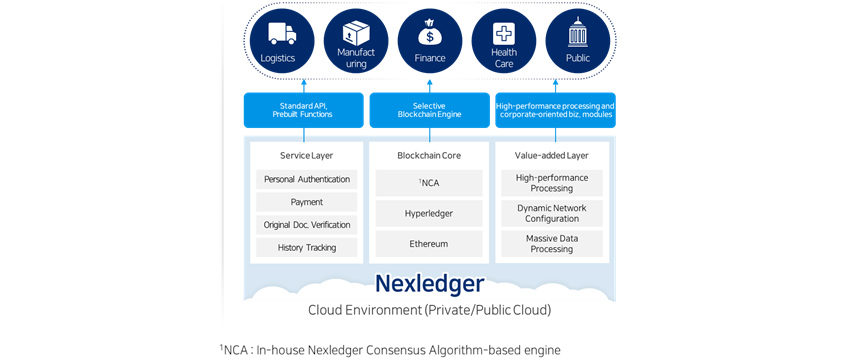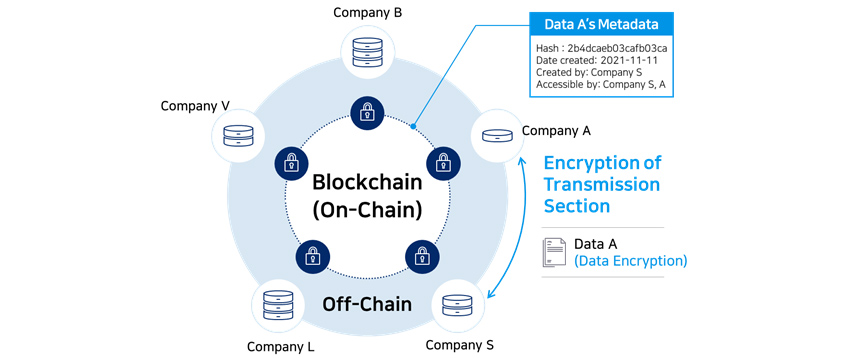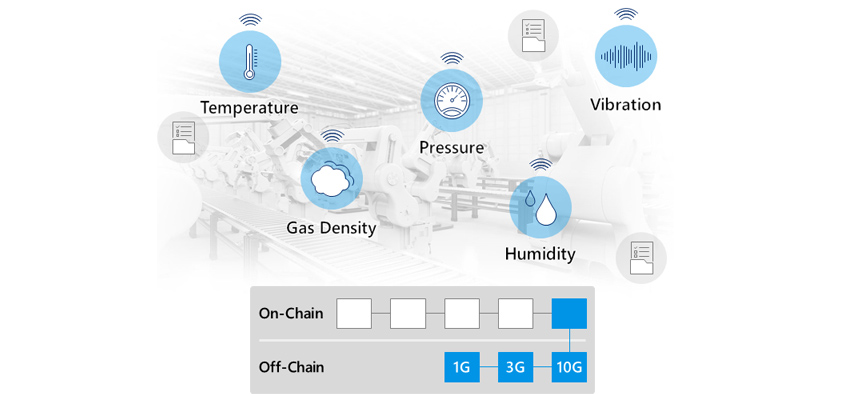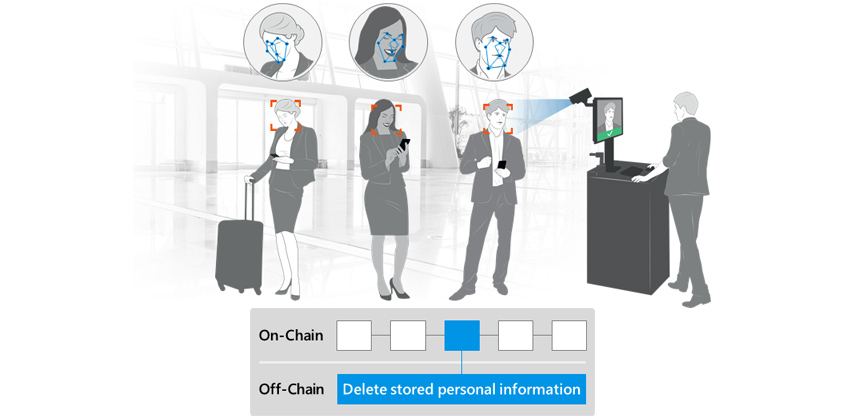
Technology Toolkit 2021 is a technical white paper describing core technologies that
are being researched and developed by Samsung SDS R&D Center. We would like to introduce in this paper a total of
seven technologies concerning AI, Blockchain, Cloud, and Security with details on their technical definition, key
features, differentiating points, and use cases to give our readers some insights into our work.
Enterprise Blockchain Technology
Concept of Enterprise Blockchain
Blockchain is the key technology to digital transformation. It provides transparency and trust using digital
encryption technology to share transaction records among network participants. Blockchain can largely be classified
into two types – public blockchain and permissioned blockchain. Public blockchain is similar to Bitcoin and
Ethereum in that it allows anyone to participate in the network. Permissioned blockchain on the other hand allows only
pre-authorized institutions or organizations to participate in the blockchain network.
Public blockchain is often described using the words “decentralization” and “anonymity”. In
other words, there is no central authority-institution managing the network, but the entire transaction details are
shared and managed by all participating members in transparent manner. However, these distinctive features of public
blockchain are also reasons why companies have difficulty introducing blockchain into their operation. Thus, came the
permissioned blockchain which allows transaction details to be shared only among specific organizations to ensure data
confidentiality and privacy.
Technology Trends
Enterprise environment requires technologies that can accommodate standards that are different from public
blockchain. In particular, permissioned blockchain is being utilized to study various technology elements to use in
enterprise environment.
First, research is being actively carried out to enable easy blockchain network construction and business scalability.
Most blockchain networks are based on open source, therefore when companies try to adopt blockchain into their
operation, it takes a lot of time for them to familiarize themselves with new technologies and provide one that fits
their business environment. Business scalability is another factor to consider after blockchain network construction.
To this end, research is being done to study tools that allow companies to easily install and deploy networks, or use
cloud to support infrastructure environment.
Second, technologies are being developed to use blockchain to process large amounts of data or manage sensitive data.
Often, blockchain is said to be unfit to handle massive data or unable to delete data due to transactions being shared
among all participants. However, the ability to process large amounts of data or delete data after they are stored is
an important function required by enterprise environment. As a result, a lot of research is being conducted on
off-chain transaction processing for massive data handling. Moreover multiple approaches are being made to use
cryptographic technologies such as zero-knowledge password to process sensitive information such as personal data.
Finally, a lot of efforts are being made to improve the performance of blockchain. Due to its nature, the performance
of blockchain is low because participating nodes generate blocks by verifying all transactions. Permitted blockchain
provides relatively higher transaction throughput compared to public blockchain as it involves fewer nodes and
requires no compensation for block creation. However, blockchain needs to deliver a higher level of performance for it
to be used in real business, and as a result research and development are underway to deliver transaction processing
that is faster.
Technology Strategies
1. Enterprise Blockchain, Nexledger
When adopting blockchain for their business, companies need to consider a number of factors like which blockchain to
choose, how to set up network, and how it will improve performance. Nexledger Universal is an enterprise-oriented
blockchain platform that integrates various blockchain distributed-consensus technologies, allowing companies to
quickly and easily build blockchain network. With the support of this technology, they can focus on creating business
values without having to worry about complex distributed consensus algorithm and working principle behind blockchain
operation.
Standard API can be used to implement service rapidly
We provide blockchain functions that are frequently used in real business environment such as user authentication
information management, point transaction, and time stamping in standard API format. This allows companies to develop
their target services more efficiently.
 Nexledger architecture contains the service layer with personal auth., payment, original doc. verification, and history
tracking, the blockchain core with NCA, Hyperledger, Ethereum, and the value-added layer with high performance
processing, DNC, MDP.
[Figure 1] Nexledger Architecture
Nexledger architecture contains the service layer with personal auth., payment, original doc. verification, and history
tracking, the blockchain core with NCA, Hyperledger, Ethereum, and the value-added layer with high performance
processing, DNC, MDP.
[Figure 1] Nexledger Architecture
Supports various businesses by integrating major blockchain technologies
Nexledger offers various blockchain cores. Users can select blockchain technology that is suitable to their needs
such as Nexledger Consensus Algorithm, Hyperledger Fabric, and Ethereum, and if needed, they can change blockchain
core with ease.
Nexledger provides specialized functions for enterprise blockchain platforms
Three specialized technologies of enterprise blockchain platform are introduced in this paper. These technologies are
operated using hyperledger fabric as a basis.
The first technology is Nexledger Manager, which enables dynamic network configuration. Anyone who have had
an experience of building a blockchain would agree the very first problem with building a blockchain is setting up an
environment for development – that it is a time-consuming process thanks to complex network components and
configuration files involved. Let's take a look at how you can easily and quickly build and manage a network using
Nexledger Manager.
The second technology is Off-Chain Manager, which can process large amount of data using blockchain. It is often said
that blockchain cannot handle massive data, but we will show you how this can be done with our off-chain Manager.
The third technology is an Accelerator that can improve transaction throughput of blockchain. Our Accelerator yields
up to 15 times higher performance than multi-project open source blockchain technology with an adaptive algorithm that optimizes transaction
processing capacity according to transaction volume.
2. Nexledger Manager
Introduction to technology
Many companies, both domestic and foreign, are trying to apply blockchain technology to their system however, in
order for them to do so, they need a blockchain platform thatch fitted with scalability and monitoring functions.
Unfortunately it may not be so easy for an individual company to build such platform on their own given that the
process can be quite costly and time consuming.
Customers can easily create and manage blockchain network using our blockchain platform, Nexledger Manager. Our technology provides high-standard blockchain network management and monitoring functions, and it can be applied to multiple areas, tailoring to business requirements.
※ Nexledger Management Console(NMC) has been renamed to Nexledger Manager as of May 2021.
Key Features
 [Figure 2] Nexledger Manager Architecture
[Figure 2] Nexledger Manager Architecture
Key element for blockchain component management and dynamic network expansion
Nexledger Manager dynamically manages blockchain components and networks.
It allows users to distribute, delete, and monitor peers, ordering service, and CA (Certificate Authority) nodes for blockchain component management. It also allows dynamic expansion of consortium, Channel and Organization network and provides Smart Contract lifecycle management feature for of blockchain network management.
There are 5 core functions that are provided by Nexledger Manager: 1) K8s-based blockchain component management 2) CA-based security/authentication system management 3) dynamic expansion of Consortium, Channel, Organization network 4) Smart contract management 5) Blockchain network monitoring. Each of these key functions will be described in more details as below.
Nexledger Manager,
K8s-based blockchain component management
Distributes and manages blockchain components dynamically in Kubernetes. The deployed components use resources
efficiently and can be recovered from failures.
CA-based security/authentication system management
Provides CA-based identification and certificate management functions so that clients or administrators can
participate and manage blockchain network. The issued ID is safely managed through electronic wallet.
Dynamic expansion of Consortium, Channel, Organization network
Sets up blockchain network members and manages business, enabling dynamic expansion of Consortium, Channel, and
Organization network.
Smart contract management
Installs Smart Contract and manages lifecycle easily.
Blockchain network monitoring
Manages network with stability and detects defects quickly by monitoring
blockchain component status and information on blocks and transactions.
Differentiating Points
Builds blockchain network with ease
Network configuration nodes have to be configured and deployed individually in order to build blockchain network
without blockchain platform. However, Nexledger Manager allows users to easily deploy and control
blockchain configuration nodes using UI. Even non-blockchain experts can easily build blockchain network within
minutes, and reflect changes in requirements such as changes in channel members and endorsement policies with ease. In
addition, it can also be used in private cloud, public cloud, and on-premise environments, and allows interconnection
among them.
Business Cases
Building policy fund loan platform using blockchain
Financial companies are made of very complicated processes including verification. Moreover, because the process
involves multiple stakeholders, loan application can be very time consuming process. To tackle these issues, we used
blockchain to build new business model and improve internal process. We were able to boost accuracy and speed the
process through sharing of application information amongst engaged parties.
Moreover, we improved work efficiency of participating organizations by building an expandable blockchain platform
with Nexledger Manager. We constructed a system that enables integrated management of multiple services by
supporting multiple applications simultaneously.
Conclusion
Nexledger Manager makes it easy and convenient for users to build and expand difficult/complex blockchain
network. It can be applied to hybrid cloud and on-premise environments and it allows interconnection amongst multiple
organizations without the burden of infrastructure constraints. In addition, in order to mitigate burden on companies
trying to introduce blockchain technology into their system, we are currently working on technology that dynamically
allocates resources according to specifications of blockchain components and another one that optimizes resources by
analyzing usage and patterns in real time.
3. Off-Chain
Introduction to Technology
Blockchain technology has limitations in that it is difficult to process data that are larger than block size, and
once recorded, they cannot be deleted. Our Off-Chain technology was developed to overcome these limitations and to
meet various business requirements.
Off-Chain refers to all actions taking place outside the blockchain (On-Chain). Our Off-Chain technology focuses on
handling data in enterprise blockchain safely and efficiently. The basic structure is set up to record hash value and
meta information in the blockchain, and actual data in the off-chain by dualizing transactions for data processing.
This enables us to handle massive data and delete sensitive information like personal information, both of which have
been the limitations of traditional blockchain systems.
 [Figure 3] Off-Chain Data Storage
[Figure 3] Off-Chain Data StorageKey Features
Safe data management is made possible with encryption of off-chain files and transmission section
Security is a very important factor to consider when sharing files using off-chain technology. Off-chain files are
encrypted using a separate key owned by each organization, and encrypted files are shared in encrypted transmission
section via TLS (Transport Layer Security) communication.
 [Figure 4] Off-Chain Data Management
[Figure 4] Off-Chain Data Management
Provides life cycle management function from storage, sharing to deletion of data
Off-chain technology allows lifecycle management of data encompassing everything from data creation, modification,
sharing, and deletion using blockchain information. Data are managed based on the blockchain information trusted by
each organization, rendering it to be secure and consistent.
Differentiating Points
Outdated data are automatically discarded according to data validity period
There are data, such as personal information, that must be automatically destroyed when their validity period expires.
Our Off-Chain technology supports automatic destruction of data based on data validity period recorded in the
blockchain. In a distributed environment, time-based business processes are difficult because precise time cannot be
agreed for each node. However, our “partial time consensus algorithm” makes it possible to agree on time
within certain range. This keeps the time requested by a requestor tamper-free, and data can be destroyed safely.
Instant management of data rights
Data can be managed using the ownership information recorded in the blockchain. Meta-information and ownership
information of data are available on 1:N relationship structure, and therefore each data can hold multiple permission
information, and maintain different permission policy by owner. This structure removes any inconvenience of having to
change policies between organizations, and manages data instantly without upgrading or modifying smart contracts.

- data
- Blockchain Data
- key : data id(uuid)
- value : name, hash, creator, timestamp, version, status, expiration
- Ownership
- key : Ownership Id
- value: data id, owner, permission, timestamp, status
- file
- key: file id(storage uuid)
- value : name, data Id, hash, creator, timestamp, versoin, expiration
Hybrid Off-Chain repository
Users can use multiple off-chain repositories such as file system and DBMS. It allows them to link existing database
system and simultaneously use dual repositories to process data efficiently.
Use Cases
Off-chain technology can be applied to any industry that wants to share massive amount of data through blockchain or
guarantee privacy between authorized companies. Here are examples of manufacturing and airport industry where
off-chain technology can be put to use.
In the case of manufacturing plants, off-chain technology can be used to facilitate transparent sharing of
manufacturing processes and enhance collaboration amongst original contractor and subcontractors. Massive amount of
design documents and equipment information that were once difficult to share using the traditional blockchain alone
can now be managed through Off-Chain Manager. By managing massive amount of real data in the off-chain repository, and
meta information of data in the blockchain, companies can make their process transparent and collaboration with one
another effective. Moreover, because manufacturing process is facilitated by easy-to-manage data access rights, it
would be easy to make changes to these access rights whenever necessary.
 You can share massive amount of data using off-chain technology. Also you can access to facility to
control temperature, pressure, vibration, gas density, humidity.
[Figure 6] Massive Data Processing & Access Control (Manufacturing)
You can share massive amount of data using off-chain technology. Also you can access to facility to
control temperature, pressure, vibration, gas density, humidity.
[Figure 6] Massive Data Processing & Access Control (Manufacturing)
Off-Chain Manager can also innovate business at airports by sharing data amongst airport stakeholders in manner that
is safe. By sharing data among various stakeholders related to departure/arrival process such as the Ministry of
Justice, Ministry of Foreign Affairs, airlines, and duty-free shops, users can shorten waiting time for airport
customers and simplify immigration process. The important point here is that data that need to be shared between
organizations often involve information that are sensitive. However users can take advantage of the fact that because
data are stored in the off-chain, they are deletable. Therefore they can delete all personal information that was
shared at the end of airport users’ journey and keep their privacy protected.
 [Figure 7]
Identity Verification and Deletion of Stored Information
[Figure 7]
Identity Verification and Deletion of Stored InformationConclusion
You can see from the examples shown above that Layer 2 technology such as Off-Chain is required to apply blockchain
to real business. Off-chain technology can be used to explore new business opportunities. Going forward, if we can
broaden our research area concerning off-chain technology, we are sure it will help us solve more issues at hand.
Performance
Basically, the performance of off-chain technology is constrained by multiple factors such as off-chain storage,
blockchain, and network (file sharing). We will need to continue to work on performance degradation issue if we are to
handle various situations when applying technology in actual business setting.
Guaranteed deletion of data
When users delete data using off-chain technology, they can also delete data owned by other organizations depending on
the permission rights that were granted. Therefore it is important that we conduct further research on how we can make
data deletion trustworthy in the off-chain that is managed by individual organization well as guarantee that data have
been deleted as agreed.
Off-Chain Computation
Blockchain transactions are known for their slow processing speed compared to
off-chain transactions. Therefore, another possible area of research we could consider is off-chain computation where
complex work would be processed in the off-chain and only the computation result would be recorded in the blockchain.
This may require a research in hardware as well as software area.
4. Accelerator
Introduction to Technology
Nexledger Accelerator was designed to improve the performance of blockchain network. In terms of transaction
throughput, Accelerator can handle approximately up to 15 times more transaction requests than Hyperledger Fabric.
 [Figure 8] Accelerator - Concept
[Figure 8] Accelerator - Concept
Key Features
Accelerator receives transaction from client on behalf of blockchain node and the corresponding transaction is
processed in three steps: Classifier, Aggregator, and Router. We will explain each step in more details as below.
Classifier
The transaction submitted by a client is delivered first to Accelerator's classifier which then sorts and categorizes
the transaction according to the rules defined by program.
Aggregator
Transactions classified by Classifier are divided and stored in multi-queues based on their type. Transactions stored
in the queue are created as one new transaction according to the rules defined by the Accelerator. The rules by which
Accelerator makes these transactions are as follows.
∙ The number of existing transactions included in the new transaction
∙ Maximum size of new transaction
∙ Wait time before a new transaction is created
Router
Router transmits new transaction created by Aggregator to blockchain network. The blockchain network
computes the transaction received from the router and returns the result value to the corresponding client.
 Accelerator contains 3 steps : Classifier, Aggregator, and Router. The flow goes from the Classifier
to the Aggregator, the Aggregator to the Router, and the Router to the Chaincode (Transaction).
[Figure 9] 3 Step Engines
Accelerator contains 3 steps : Classifier, Aggregator, and Router. The flow goes from the Classifier
to the Aggregator, the Aggregator to the Router, and the Router to the Chaincode (Transaction).
[Figure 9] 3 Step Engines
Differentiating Points
Blockchain can largely be divided into two areas: public blockchains such as Bitcoin and Ethereum, and private
enterprise blockchains such as Hyperledger Fabric and Corda. Unfortunately, these traditional blockchain platforms
have yet to satisfy TPS (Transaction Per Second) standard required by business systems currently in service.
However our Accelerator shows performance thats up to 15 times higher than the traditional blockchain network (e.g.
Hyperledger Fabric), addressing the limitations of these traditional blockchain networks.
Moreover, Accelerator is a second-layer architecture software designed in a modular structure that can be easily
connected with other blockchains. Thus, users can easily incorporate Accelerator without making major changes to the
legacy system.
 [Figure 10] 2nd layer Architecture
[Figure 10] 2nd layer Architecture
Finally, Accelerator is effective operation-wise as it supports optimal throughput calculation by analyzing the
performance and network status of existing infrastructure using adaptive algorithm.
Use Case
Digital ticketing is a system that allows you to book, search, and edit tickets on applications or web pages you are
all familiar with. You must have had an experience where the system was not working properly due to excessive in-flow
traffic generated by specific event. We applied Accelerator to address these commonly occurring problems of everyday
life, and the results are as follows.
 Combining mobile
ticketing blockchain network and blockchian capacity reinforcement module confirmed the response speed reduced by
97.5% compare to without the Accelerator.
[Figure 11] Accelerator for Mobile Ticketing
Combining mobile
ticketing blockchain network and blockchian capacity reinforcement module confirmed the response speed reduced by
97.5% compare to without the Accelerator.
[Figure 11] Accelerator for Mobile Ticketing
If you look at reservation details and results before and after the Accelerator is applied to digital ticketing
system, you can see that the average response time dramatically went down with Accelerator. This result is meaningful
in that the blockchain network supporting Accelerator can be incorporated into systems that are used frequently in our
daily life and create synergy.
Conclusion
Our Accelerator is beneficial in a number of ways. First, as mentioned above, the data throughputs of existing
blockchain networks lag far behind the throughput that business requires. Our Accelerator can eliminate this problem
with its ability to produce performance that is up to 15 times faster than that of Hyperledger Fabric. Second, distributed
network including blockchain requires a consensus process to store data, but this process is very expensive. Our
Accelerator can improve the speed of consensus process by bringing and processing the consensus required for each
transaction as one, thereby reducing consensus processing cost. Third, we provide Software Development Kit that helps
developers, even those with the least experience, develop and test these beneficial accelerators with ease.
 4. Enterprise Blockchain Technology(Nexledger Management Console, Off chain, Accelerator)
4. Enterprise Blockchain Technology(Nexledger Management Console, Off chain, Accelerator) Play Video
# Reference
https://github.com/nexledger/accelerator
▶ The content is proected by law and the copyright belongs to the author.
▶ The content is prohibited to copy or quote without the author's permission.
- The First Step to Smart Textual Analysis, KoreALBERT
- Smart QA Model That Understands Even Complex Tables
- I Will Give You Data, Label It~ Auto Labeling!
- The Connecting Link for Everything in the World, It’s in the Knowledge Graph
- Easy and Simple Blockchain Management, Nexledger!
- No More Short of GPU!
- In the Age of When Customer Data Must Be Treated as a King, PET Will Take on the Responsibility
- It is Important to Prevent Security Risks from Development Phase! Trust CAFA+ to Do the Job

Hansaem SEO, Blockchain Research Lab at Samsung SDS R&D Center
He is involved in research and development of blockchain platform.
Hwayong OH, Blockchain Research Lab at Samsung SDS R&D Center
He is involved in research and development of blockchain platform.
Jungeun LEE, Blockchain Research Lab at Samsung SDS R&D Center
The main focus of her research was on off-chain transaction processing and decentralized identity. She is currently working on blockchain performance enhancement solution and consensus algorithm for finance industry.
Youngyoo HEO, Blockchain Research Lab at Samsung SDS R&D Center
He is currently working on research & development of blockchain platform and off-chain technology.
If you have any inquiries, comments, or ideas for improvement concerning technologies introduced in Technology Toolkit 2021, please contact us at techtoolkit@samsung.com.
- An Enterprise NFT, How to Use It, and How to Develop It
- NFT, Would It Be Used for Anything Other than Collecting?
- Introducing Maritime Blockchain Project to World Customs Officers
- Samsung SDS’s Blockchain Platform Nexledger Goes Global Beyond Korea
- [Video] What Can Nexfinance™ Do for You and Your Business?
